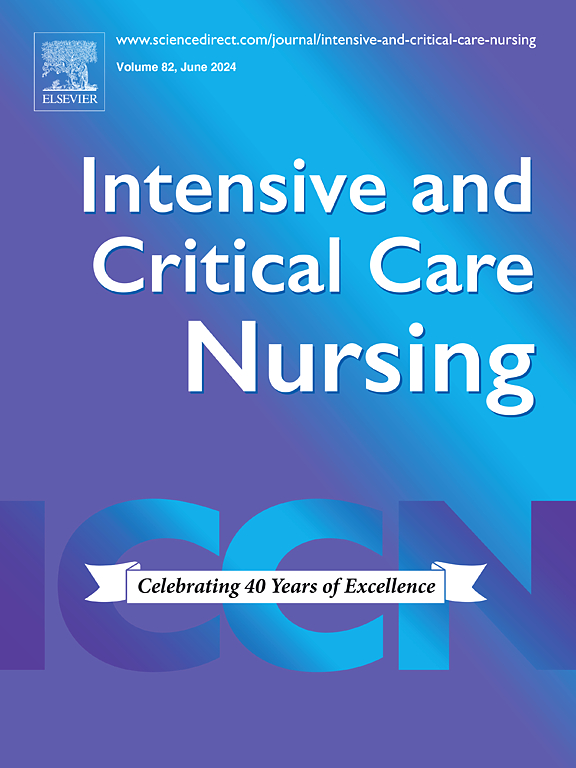The association between self-reported symptoms, rehabilitation and long-term functional disability in ICU survivors
IF 4.7
2区 医学
Q1 NURSING
引用次数: 0
Abstract
Background
The relationship between self-reported symptoms and functional disability in ICU survivors remains unclear. Rehabilitation is considered necessary in supporting ICU survivors’ recovery and functional outcomes, though evidence remains inconclusive.
Aims
To investigate the association between self-reported symptoms and the role of post-ICU rehabilitation on functional disability in ICU survivors.
Methods
Functional disability was measured using the Lawton Instrumental Activities of Daily Living (I-ADL) scale, dichotomised as “with or without disabilities” based on established threshold. Data were collected pre-ICU and at 3, 6, and 12 months post-ICU admission. To account for repeated measures over time, generalised linear model for repeated measures with a binary outcome was used to estimate possible predictive factors associated with functional disability. Separate analyses were performed for patients who did and did not receive post-ICU rehabilitation.
Results
Among 331 included ICU survivors, 165 (49.8 %) received post-ICU rehabilitation during the first year. A higher level of pain/discomfort (OR = 1.47; 95 %CI: [1.13–1.91]), higher PTSS score (OR = 1.05; 95 %CI: [1.03–1.07]), and higher depression score (OR = 1.13; 95 % CI: [1.05–1.22]) at three months were associated with functional disability during the first year. The odds of having functional disability were lower at twelve-month follow-up compared to three-month follow-up (OR = 0.46; 95 %CI: [0.26–0.83]). Patients who received rehabilitation had lower odds of having functional disability both at six months (OR = 0.42; 95 %CI: [0.18–0.95]) and at twelve months (OR = 0.36; 95 %CI: [0.16–0.82]).
Conclusions
Self-reported symptoms at three months were associated with having functional disability in ICU survivors during the first year. ICU survivors who received post-ICU rehabilitation had improved functional disability compared to those who did not receive rehabilitation.
Implications for clinical practice
Our study underscores the importance of screening self-reported symptoms during post-ICU follow-up and the potential role of post-ICU rehabilitation in improving functional disability among ICU survivors.
ICU幸存者自我报告的症状、康复和长期功能障碍之间的关系
背景:ICU幸存者自我报告的症状与功能障碍之间的关系尚不清楚。康复被认为是支持ICU幸存者康复和功能结局的必要条件,尽管证据仍不确定。目的:探讨ICU幸存者自我报告症状与ICU后康复对功能障碍的作用之间的关系。方法:使用劳顿日常生活工具活动(I-ADL)量表测量功能障碍,根据既定阈值分为“有或无残疾”。数据收集于icu前、入院后3、6、12个月。为了解释随时间的重复测量,使用具有二元结果的重复测量的广义线性模型来估计与功能残疾相关的可能预测因素。对接受和未接受icu后康复治疗的患者进行单独分析。结果:在331例ICU幸存者中,165例(49.8%)在第一年接受了ICU后康复。三个月时较高水平的疼痛/不适(OR = 1.47; 95% CI:[1.13-1.91])、较高的PTSS评分(OR = 1.05; 95% CI:[1.03-1.07])和较高的抑郁评分(OR = 1.13; 95% CI:[1.05-1.22])与第一年的功能障碍相关。随访12个月发生功能障碍的几率低于随访3个月(OR = 0.46; 95% CI:[0.26-0.83])。接受康复治疗的患者在6个月时(OR = 0.42; 95% CI:[0.18-0.95])和12个月时(OR = 0.36; 95% CI:[0.16-0.82])发生功能障碍的几率较低。结论:在ICU存活患者中,3个月时自我报告的症状与第一年的功能障碍相关。与未接受康复治疗的患者相比,接受ICU后康复治疗的ICU幸存者功能障碍有所改善。临床实践意义:我们的研究强调了在ICU后随访中筛查自我报告症状的重要性,以及ICU后康复在改善ICU幸存者功能障碍中的潜在作用。
本文章由计算机程序翻译,如有差异,请以英文原文为准。
求助全文
约1分钟内获得全文
求助全文
来源期刊

Intensive and Critical Care Nursing
NURSING-
CiteScore
6.30
自引率
15.10%
发文量
144
审稿时长
57 days
期刊介绍:
The aims of Intensive and Critical Care Nursing are to promote excellence of care of critically ill patients by specialist nurses and their professional colleagues; to provide an international and interdisciplinary forum for the publication, dissemination and exchange of research findings, experience and ideas; to develop and enhance the knowledge, skills, attitudes and creative thinking essential to good critical care nursing practice. The journal publishes reviews, updates and feature articles in addition to original papers and significant preliminary communications. Articles may deal with any part of practice including relevant clinical, research, educational, psychological and technological aspects.
 求助内容:
求助内容: 应助结果提醒方式:
应助结果提醒方式:


